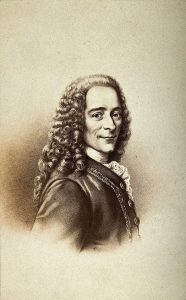|Voltaire Icon of Paris|
Voltaire (1694 – 1778) is a humanist who fought all his life against religious fanaticism and for freedom. Author of the Philosophical Letters and Candide or Optimism, he is a French poet, writer, playwright, historian and philosopher born on November 21, 1694 and died on May 30, 1778 in Paris. In addition, he is one of the fathers of the French Revolution of 1789, through his writings and philosophy about freedom. Voltaire was a terrific business man and a vegetarian because he could not stand the killing of animals. In his book “Candide”, Voltaire denounces slavery in particular through the character of the negro from Surinam, in chapter 19. It is the very example of the violation of human rights and freedom which is exposed in this chapter.

François-Marie Arouet, Voltaire. Photograph by E. Desmaisons
Voltaire Timeline
- 1694 November 21: François-Marie Arouet (later known as Voltaire) is born in Paris, France.
- 1704-1711 Attends the Jesuit school Collège Louis-le-Grand in Paris, where he receives a classical education.
- 1711-1713 Studies law, although he never completes his legal studies as he is more interested in literature and writing.
- 1717-1718 May 1717: Imprisoned in the Bastille for 11 months due to his satirical writings against the French government and the regent, Philippe II, Duke of Orléans.
- 1718 Adopts the pen name “Voltaire.”December: His play “Oedipus” is successfully performed, establishing him as a playwright.
- 1726-1729 Exiled to England after a quarrel with the Chevalier de Rohan. In England, he is influenced by British writers such as John Locke and Isaac Newton.
- 1733 Publishes “Letters Concerning the English Nation” (also known as “Philosophical Letters”), praising English society and critiquing French institutions. This leads to his works being banned in France.
- 1746 Elected to the Académie Française.
- 1750-1753 Lives in the court of Frederick the Great in Potsdam, Prussia, enjoying the protection and patronage of the King of Prussia.
- 1759 Publishes “Candide,” one of his most famous works, which satirizes the optimistic philosophy of Leibniz.
- 1764 Publishes “Dictionnaire philosophique” (Philosophical Dictionary), a series of articles criticizing the Catholic Church and advocating for freedom of thought and expression.
- 1778 February: Returns to Paris after a long exile in Ferney, near the Swiss border.
- May 30: Dies in Paris.
Posthumous Recognition
Voltaire’s remains are moved to the Panthéon in Paris in 1791, honoring him as a champion of Enlightenment thought and a key figure in French literature and French philosophy. Voltaire’s life was marked by his relentless advocacy for civil liberties, his criticism of religious dogma, and his contributions to literature and philosophy.
His childhood with the Jesuits and his uncle’s influence
Childhood
Voltaire born as François-Marie Arouet is the son of a notary. He was born in Paris in 1694. His first years were austere. Only his godfather, an abbot, comes out of the frame and makes he reads, including works censored by the authorities. It was this godfather who one day introduced François-Marie to Ninon de Lenclos, a French author, courtesan and patron of the arts, then 88 years old.
His mother died when he was 7 years old. From 9 to 17 years old, he attended the Louis-le-Grand college, in Paris, school founded in 1563 by the Jesuits. There, he was introduced to the theater and poetry, made friends with future great aristocrats and already showed his great ambition. In 1714, at the age of 20, he was found a clerk in a study in the rue des Grands-Degrés in Paris 5th district but he takes more pleasure in frequenting literary salons. After the death of Louis XIV in 1715, Voltaire embellished the courtyard with tales and entertainment. The Regent and then the Queen granted him a pension.
The Baroness of Fontaine-Martel
In December 1731, he moved to the Baroness of Fontaine-Martel rue de Valois in 1782 (near n ° 20). The Bank of France has since taken possession of the buildings. Voltaire was then 28, the baroness was over 60. Their common pleasure is to receive people and play theater, including his plays. Following the death of the baroness, in May 1733 he left the Hôtel de la Fontaine-Martel. He lives in rue de Brosse Paris 4th district later in the year.
Voltaire Bastille imprisonment and his exiles
Jail and freedom
The Bastille jail in Paris, Voltaire knows it as well as Diderot and the Encyclopédistes, the Enlightenment philosophers. He spent 11 months there in 1717, accused of insulting the regent Philippe II of Orleans. Voltaire wrote his first play – Oedipus – in the shadow of the Bastille. He chose his famous pen name in 1719. This tragedy was performed a few months later at the Comédie-Française in Paris.
He returned to the Bastille in 1726. For a remark taken as an insult, the Chevalier de Rohan had him thrashed in front of the hotel at 62 rue Saint-Antoine. The writer takes up fencing classes to avenge his honor. However, a letter by the Rohans family had him imprisoned in the Bastille and then forced him to exile in England until 1728. There, he discovered that the freedom of opinion is possible and exists.
After these sad experiences, however, he is not immune to threats and death. Despite of it, he makes up his mind : to be able to write in total freedom while living on other income. He published in Amsterdam, in La Haye or Geneva to escape royal censorship.
Voltaire was a millionaire in his forties
Copyrights did not exist at that time and it was normal for publishers to print anything that came into their hands and not share their profits with the writer. This is why Voltaire derived very little profit from his writings. He understood early on that it was necessary to have an independent livelihood if he was to encourage the reform of society through his books.
Voltaire was a millionaire in his forties. When he was in his twenties, he cultivated the friendship of wealthy bankers, especially the Pâris brothers. It was through them that he learned to invest, to speculate etc… the Pâris had a contract to supply the French army with food and ammunition and they invited him to participate with them in this extremely profitable enterprise. When he was in England, he noticed that you could make a lot of money in foreign trade and he invested in ships that sailed around the world. He also invested in works of art, lent to individuals and took interest on the loans.
Voltaire’s secretary, Longchamp, reports that Voltaire’s income in 1749 was 80,000 francs, which corresponds approximately to $600,000 (592,200 Euros) today. Voltaire kept investments which yielded 45,000 francs in several foreign countries. This was done to ensure his means of subsistence in case he had to leave France quickly.
His geographical journey starts from the Parisian salons to settle from 1734 in various places abroad within Europe or not far from a border, just in case.
The love of his life and his Commitment to Freedom
Émilie du Châtelet
In Cirey-sur-Blaise (Haute-Marne), he stops by Madame du Châtelet, marquise, whom he has known for a year. The Château de Cirey, close to the border with the then independent Lorraine, is an ideal refuge. In fact, seduced by the place and above all by Madame du Châtelet, Emilie de Breteuil, he settled there for 15 years, until the death of Émilie du Châtelet in 1749. They also like to settle in Paris, on Saint Louis Island, at Emilie’s mansion, the Hôtel Lambert, a private mansion located on the Île Saint-Louis close to Notre Dame, at no. 2 rue Saint-Louis-en-l’Île. The arrangement was simple: he maintained the castle and Émilie (who, after living in Paris for some time, also moved to Cirey), while her husband M. du Châtelet devoted himself to other mistresses as was customary, if not recommended for someone of his rank.
Emilie’s profile
Emilie has something to charm the philosopher. It’s Voltaire as a “she”. At the age of 12, she practiced German, Latin and Greek. Four hours of sleep are enough for her every night. Emilie became a high profile mathematician thanks to her father, she was also talented in music, theatre. She was also a big spender in dresses and jewellery. Highly intelligent and cultivated, she had a passionate love for life and she was the love of Voltaire’s life. Voltaire and her had a true intellectual love story even though they had a free relationship.
From Cirey, Voltaire sometimes made stays in Paris, in particular with the Châtelet family at the Lambert hotel (1-3 quai d’Anjou, entered by 2 rue Saint-Louis-en-L’Ile) in 1742, or rue Molière (at the current level of the first even numbers; at the time, at 43 rue Traversière) in 1746 then in 1749-50. He was appointed historiographer to the king in 1745 and became an academician the following year. But he did not have the favor of Louis XV.
Berlin Geneva Fernay Paris
Between 1750 and 1753 he lived in Berlin. His story of the Doctor Akakia discontented Maupertuis, president of the Berlin Academy, and Voltaire had to leave Prussia and the court of Frederick II, with whom relations were already electric. Despite of his desire to settle again in Paris, he bought a property in Montriond near Lausanne, then, in early 1755, Les Délices near Geneva.
He had to leave Switzerland soon and obtained a lease for life from the seigneury of Tournay in Prigny, and finally bought the Château de Ferney at the start of 1759, on the Franco-Swiss border. While developing the Délices and the lands of Tournay, he also financed numerous businesses in the village of Ferney, which was greatly transformed under his impetus, becoming the incarnation of the small farm of his book Candide and a necessary stopover for any enlightened traveler of the time.
Calas is rehabilitated thanks to Voltaire
From 1756 he collaborated in the writing of L’Encyclopédie. A year later, he wrote Candide. In 1762, he defended in his book le traité de la tolérance, Jean Calas a Protestant who was executed for having, they say, murdered his son to prevent him from renouncing his Protestant faith for Catholicism faith. After 3 years of campaigning, Calas is rehabilitated thanks to Voltaire.
Fanaticism is a monster that dares to call itself the son of religion
He did not return to Paris until 1778, citing the pretext of rehearsing his tragedy Irene, which was to be performed at the Comédie-Française. It is a huge success. The Comédie-Française brought a bust of Voltaire at the end of the performance and the actors sing verses in honor of the great man. He was acclaimed by all of Paris. He moved to 27 quai Voltaire, from February 1778 until his death on May 30 at 83, in a room on the second floor overlooking the courtyard. Before his death, the Church, which he had criticized all his life for its refusal to appeal to reason, its obscurantism and censorship, asked him to renounce his anti-Christian ideas in order to give him the extreme unction. However, Voltaire never denied his works even though he always believed in God.
I die worshiping god, loving my friends, not hating my enemies, hating superstition
To the end, he was the greatest icon of – Tolerance and Freedom – freedom of thought, of speech, toward the Catholic Church. Voltaire had the merit of putting his actions in accordance with his speech. This is why he inspired the Revolution of 1789. His body was transferred to the Sellieres Abbey, in Champagne, for which Voltaire’s nephew was responsible. Today, it is a private property but this one preserved the vestige of the burial.
Voltaire enters the Pantheon
When Voltaire’s body was transferred to the Pantheon in Paris on July 11, 1791, 13 years after his death, some of the organs of the late philosopher were lost in the process. Emblematic figure of the Age of Enlightenment, it is quite naturally that the philosopher is transferred to the Pantheon in July 1791.
His heart and brain are missing !
Indeed, when Voltaire died on May 30, 1778, he was visiting Paris with his friend the Marquis de Villette. The latter then orders the embalmer to extract the heart of the philosopher to keep it. Also, the Marquis knows his friend’s attachment to the Château de Ferney, the residence of the author of Candide for nearly 20 years. Therefore, he bought the building in order to expose the heart of his deceased friend. The organ of the philosopher will remain in his old chamber, transformed into a sanctuary for the occasion, for almost a century. You can visit the château de Fernay nowadays. It is located French side, close to Geneva.
His Heart
In 1864, Napoleon III decided to bring the heart of the philosopher to Paris. He transfered it to the National Library. He had it placed in the plaster of a statue made by sculptor Houdon: it is still there today.
His Brain
Voltaire’s brain had been kept by M. Mitouart, the apothecary in charge of his autopsy and embalming. This embalmer, far from being disinterested, did not hesitate to expose Voltaire brain in his dispensary. However, the descendants of Mitouart would prefer to exchange Voltaire’s brain. Indeed, they exchange his brain at the Comédie-Française at the beginning of the 20th century. They did it for two places in the orchestra reserved for 20 years! The theater then installed Voltaire’s brain in Voltaire’s statue made by Houdon which can still be admired today.
Enjoy a private tour guide in Paris about Voltaire.
Emy,

